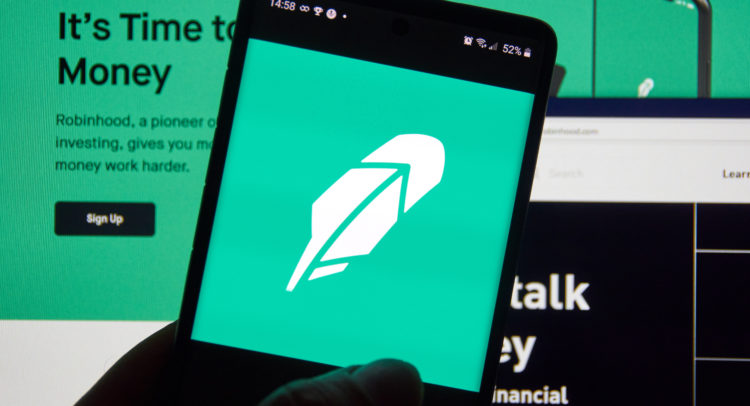As a trading platform, Robinhood Markets (HOOD) proved itself a hit with the mobile-friendly younger generations. However, it has its share of problems regarding profitability.
A recent analyst downgrade sent the company reeling, losing 4.1% in Friday’s premarket trading. That loss continued into today’s trading, with the currently stock down over 6%.
I’m cautiously bullish on Robinhood, though, thanks to its longer-term potential and some new possible developments that could give it a boost down the line.
The last year for Robinhood shares was all about finding its level. After a sudden spike in August doubled share prices, Robinhood immediately began to fall. It continued that fall until around mid-December, when the company settled into the $10 to $20 per share range.
The latest news, meanwhile, deals a blow to Robinhood supporters. Goldman Sachs issued a new rating on the company. It wasn’t welcome news. Goldman Sachs’ Will Nance lowered the rating from “neutral” to Sell and also cut his price target.
The new price target stands at $13 per share, down from $15. Perhaps worst of all, Nance questioned whether or not the company could even achieve profitability in 2023 due to a range of headwinds facing the company.
Wall Street’s Take
Turning to Wall Street, Robinhood has a Hold consensus rating. That’s based on five Buys, four Holds, and three Sells assigned in the past three months. The average Robinhood price target of $17.36 implies 53.76% upside potential.
Analyst price targets range from a low of $11 per share to a high of $45 per share.

Support Emerges From Multiple Quarters, Except Dividend History
Potential Robinhood investors will find they’re in good company. The TipRanks 13-F Tracker reveals that hedge fund involvement with Robinhood shares is on the rise. Hedge funds bought an additional 12.9 million shares in the last quarter. This was despite the company’s share price plunging from its post-IPO highs.
Further, insider investors bought a reasonable new stake in the company. Insiders added an extra $137,700 worth of shares over the last three months.
However, Robinhood’s dividend history bears no close scrutiny. The company has yet to issue a dividend and appears to have no plans to start doing so.
A Potentially Big Long-Term Play
A company that loses roughly 85% of its value over the space of about six months may not sound like a great target for investors. Indeed, Goldman Sachs is already questioning the company’s ability to be profitable in the next two years. There is, however, a case for improvement in the company.
Robinhood has been actively expanding its operations for the last few weeks now. For instance, just recently, the company announced extended trading hours. This is part of a larger push to get round-the-clock investment capability going, a move some investors will welcome.
Further, Robinhood was also recently spotted bolstering its credibility in cryptocurrency. It joined the Crypto Market Integrity Coalition, an industry group that’s out to make crypto a safer market overall. The CMIC specifically focuses on market manipulation issues. It also focuses on improving the perception of crypto among regulatory bodies.
Such moves will likely go a long way toward encouraging more users to get involved. One of the biggest problems Goldman spotted with Robinhood is user engagement at the retail level. New features like these could bring new users back.
However, some points are much tougher to fight. Goldman pointed out that Robinhood would need “solid macro-economic tailwinds” to succeed. Those may be difficult to come by. That’s especially true given recent issues of inflation on just about everything from fuel to food.
A potential recession lurks in the background in U.S markets, meanwhile. That underscores the potential difficulty Robinhood’s investors will have finding the cash to buy stocks and cryptocurrency.
This is part of why Robinhood might be a good long-term buy. Assuming the current economic issues we’re facing worldwide are part of a cyclical pattern, we may see good times again in a year or two. Robinhood buyers right now may find themselves positioned to reap the benefits after the downturn runs its course.
Concluding Views
Robinhood is currently trading around its lowest point. It’s close to its lowest price targets. It’s also actively working to return to prominence. Those are all points in the company’s favor.
Buying in now may position patient investors to win out in the long term. A nice position can be had comparatively inexpensively; 100 shares will sell for around a decent television’s price.
There is, however, a possibility that Robinhood could go lower. Ultimately, Robinhood is an investment platform operating in an environment where people may have less to invest for a while. Robinhood stands to lose for the duration of that downturn. Given that we never know how long such downturns last, that could be a serious problem for the company.
This is why I remain cautiously bullish. There’s a clear path to victory ahead for Robinhood. However, it’s going to take a lot of moving parts working just right to get there. That’s never easy to pull off. Still, with share prices what they are, there may be growth to come after a while, anyway.
Download the TipRanks mobile app now
To find good ideas for stocks trading at attractive valuations, visit TipRanks’ Best Stocks to Buy, a newly launched tool that unites all of TipRanks’ equity insights.
Read full Disclaimer & Disclosure









